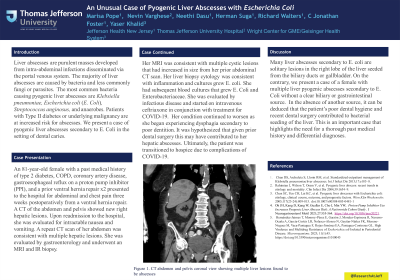Tuesday Poster Session
Category: Liver
P3959 - An Unusual Case of Pyogenic Liver Abscesses With Escherichia coli
Tuesday, October 24, 2023
10:30 AM - 4:00 PM PT
Location: Exhibit Hall

Has Audio

Marisa Pope, DO
Jefferson Health
Stratford, NJ
Presenting Author(s)
Marisa Pope, DO1, Nevin Varghese, MD2, Neethi Dasu, DO3, Herman Suga, DO4, C Jonathan Foster, DO4, Richard Walters, DO4, Yaser Khalid, DO5
1Jefferson Health, Stratford, NJ; 2Thomas Jefferson University Hospital, Philadelphia, PA; 3Jefferson Health, New Jersey, NJ; 4Jefferson Health, Cherry Hill, NJ; 5Wright Center for GME/Geisinger Health System, Scranton, PA
Introduction: Liver abscesses are purulent masses that develop from intra-abdominal infections disseminated from the portal venous system. The majority of liver abscesses are caused by bacteria and less commonly fungi or parasites. The most common bacteria causing pyogenic liver abscesses are Klebsiella pneumoniae, Escherichia coli (E. Coli), Streptococcus anginosus, and anaerobes. The incidence is increased in patients with type II diabetes mellitus or underlying malignancy. We present a case of pyogenic liver abscesses secondary to Escherichia coli in the setting of dental caries.
Case Description/Methods: An 81-year-old female with a past medical history of type 2 diabetes, COPD, coronary artery disease, gastroesophageal reflux on a proton pump inhibitor (PPI), and a prior ventral hernia repair x2 presented to the hospital for abdominal and chest pain three weeks postoperatively from a ventral hernia repair. A CT of the abdomen and pelvis showed new right hepatic lesions. Upon readmission to the hospital, she was evaluated for intractable nausea and vomiting. A repeat CT scan of her abdomen was consistent with multiple hepatic lesions. She was evaluated by gastroenterology and underwent an MRI and IR biopsy. Her MRI was consistent with multiple cystic lesions that had increased in size from her prior abdominal CT scan. Her liver biopsy cytology was consistent with inflammation and cultures grew E. coli. She had subsequent blood cultures that grew E. Coli and Enterobacteriaceae. She was evaluated by infectious disease and started on intravenous ceftriaxone. in conjunction with treatment for COVID-19. Her condition continued to worsen as she began experiencing dysphagia secondary to poor dentition. It was hypothesized that given prior dental surgery that it may have contributed to her hepatic abscesses. Ultimately, the patient was transitioned to hospice due to complications of COVID-19.
Discussion: Many liver abscesses secondary to E. coli are solitary lesions in the right lobe of the liver seeded from the biliary ducts or gallbladder. On the contrary, we present a case of a female with multiple liver pyogenic abscesses secondary to E. Coli without a clear biliary or gastrointestinal source. In the absence of another source it can be deduced that the patient’s poor dental hygiene and recent dental surgery contributed to bacterial seeding of the liver. This is an important case that highlights the need for a good past medical history and differential diagnosis.
Disclosures:
Marisa Pope, DO1, Nevin Varghese, MD2, Neethi Dasu, DO3, Herman Suga, DO4, C Jonathan Foster, DO4, Richard Walters, DO4, Yaser Khalid, DO5. P3959 - An Unusual Case of Pyogenic Liver Abscesses With Escherichia coli, ACG 2023 Annual Scientific Meeting Abstracts. Vancouver, BC, Canada: American College of Gastroenterology.
1Jefferson Health, Stratford, NJ; 2Thomas Jefferson University Hospital, Philadelphia, PA; 3Jefferson Health, New Jersey, NJ; 4Jefferson Health, Cherry Hill, NJ; 5Wright Center for GME/Geisinger Health System, Scranton, PA
Introduction: Liver abscesses are purulent masses that develop from intra-abdominal infections disseminated from the portal venous system. The majority of liver abscesses are caused by bacteria and less commonly fungi or parasites. The most common bacteria causing pyogenic liver abscesses are Klebsiella pneumoniae, Escherichia coli (E. Coli), Streptococcus anginosus, and anaerobes. The incidence is increased in patients with type II diabetes mellitus or underlying malignancy. We present a case of pyogenic liver abscesses secondary to Escherichia coli in the setting of dental caries.
Case Description/Methods: An 81-year-old female with a past medical history of type 2 diabetes, COPD, coronary artery disease, gastroesophageal reflux on a proton pump inhibitor (PPI), and a prior ventral hernia repair x2 presented to the hospital for abdominal and chest pain three weeks postoperatively from a ventral hernia repair. A CT of the abdomen and pelvis showed new right hepatic lesions. Upon readmission to the hospital, she was evaluated for intractable nausea and vomiting. A repeat CT scan of her abdomen was consistent with multiple hepatic lesions. She was evaluated by gastroenterology and underwent an MRI and IR biopsy. Her MRI was consistent with multiple cystic lesions that had increased in size from her prior abdominal CT scan. Her liver biopsy cytology was consistent with inflammation and cultures grew E. coli. She had subsequent blood cultures that grew E. Coli and Enterobacteriaceae. She was evaluated by infectious disease and started on intravenous ceftriaxone. in conjunction with treatment for COVID-19. Her condition continued to worsen as she began experiencing dysphagia secondary to poor dentition. It was hypothesized that given prior dental surgery that it may have contributed to her hepatic abscesses. Ultimately, the patient was transitioned to hospice due to complications of COVID-19.
Discussion: Many liver abscesses secondary to E. coli are solitary lesions in the right lobe of the liver seeded from the biliary ducts or gallbladder. On the contrary, we present a case of a female with multiple liver pyogenic abscesses secondary to E. Coli without a clear biliary or gastrointestinal source. In the absence of another source it can be deduced that the patient’s poor dental hygiene and recent dental surgery contributed to bacterial seeding of the liver. This is an important case that highlights the need for a good past medical history and differential diagnosis.
NA
Disclosures:
Marisa Pope indicated no relevant financial relationships.
Nevin Varghese indicated no relevant financial relationships.
Neethi Dasu indicated no relevant financial relationships.
Herman Suga indicated no relevant financial relationships.
C Jonathan Foster indicated no relevant financial relationships.
Richard Walters indicated no relevant financial relationships.
Yaser Khalid indicated no relevant financial relationships.
Marisa Pope, DO1, Nevin Varghese, MD2, Neethi Dasu, DO3, Herman Suga, DO4, C Jonathan Foster, DO4, Richard Walters, DO4, Yaser Khalid, DO5. P3959 - An Unusual Case of Pyogenic Liver Abscesses With Escherichia coli, ACG 2023 Annual Scientific Meeting Abstracts. Vancouver, BC, Canada: American College of Gastroenterology.
